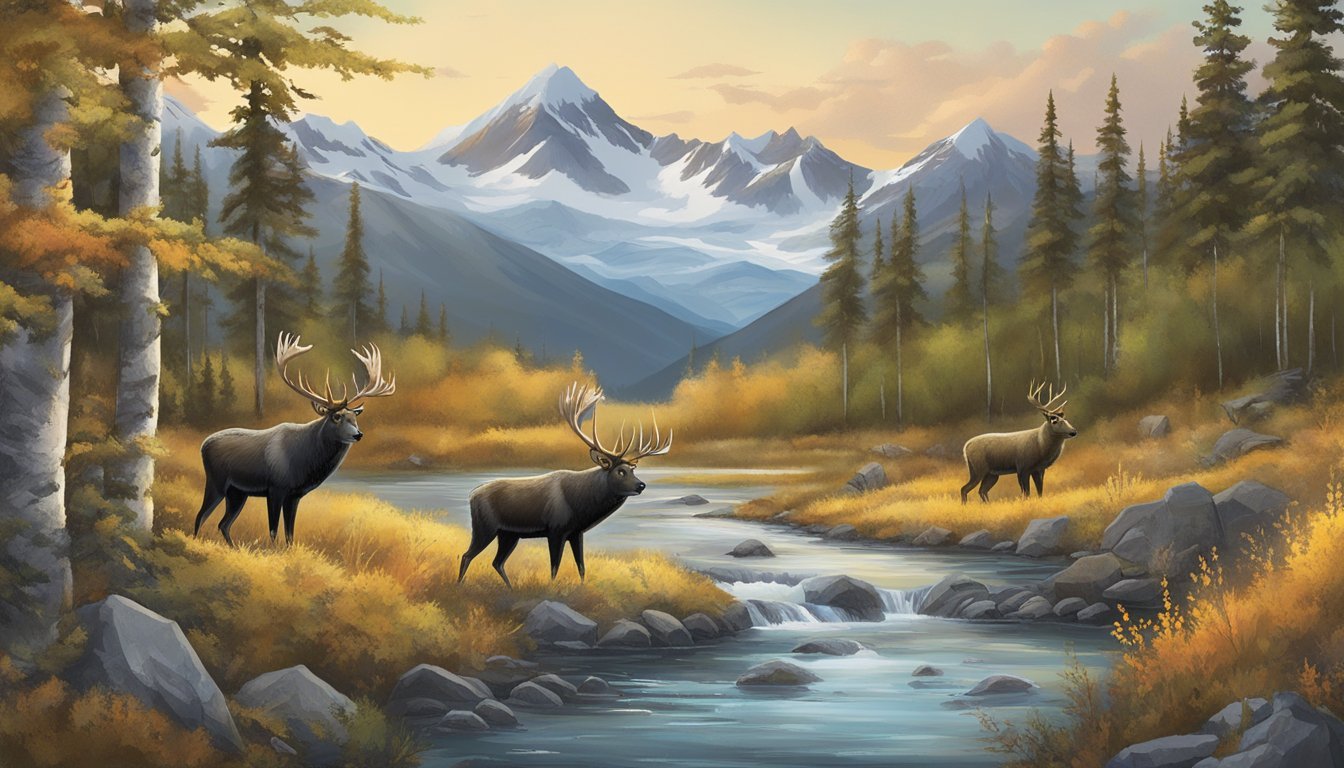Hunting Seasons in Alaska
Your Essential Guide to Dates and Regulations
This Article is Part of Our Hunting Seasons Guide for All 50 US States
Alaska offers a diverse and expansive hunting landscape with a variety of seasons catering to different species and geographical areas. With its rugged terrain and wide expanse, it provides hunters with an opportunity to engage in a sport that is deeply woven into the local culture and subsistence lifestyle. Hunters in Alaska must be aware of the specific season dates, which typically start in August and September and can extend into the winter months for certain species.
Regulations are put in place by the Alaska Department of Fish and Game to ensure sustainable wildlife populations and to meet the subsistence needs of local communities. These rules can be specific and complex, often detailed in regulatory booklets that highlight not only dates and permissible species but also the necessary licenses and tags required for legal hunting. Compliance with these regulations is essential, as they are enforced by wildlife authorities and subject to revision, including emergency orders which may alter existing season schedules.
Hunting in Alaska is not just a pastime; it's an essential part of life for many residents, providing food and fur for the winter. The state's hunting regulations reflect the importance of this practice, balancing the needs of subsistence hunters with the preservation of Alaska's rich biodiversity. Whether pursuing small game like grouse or hare or aiming for larger game such as muskox and brown bear, hunters are encouraged to plan meticulously and adhere to the established rules for a successful and responsible hunting experience.
Understanding Alaska's Hunting Seasons
Alaska's hunting seasons offer a diverse range of opportunities across various game species, each with specific timelines and regulations to ensure sustainable wildlife management.
General Overview of Seasons
In Alaska, hunting seasons are designated to manage wildlife populations effectively and provide hunting opportunities. Season dates can range from August to April, depending on the game and region.
Big Game Seasons
Big game species such as moose, caribou, and elk have their designated seasons, generally starting from late August through mid-November. Brown bear and Dall sheep hunting often require special permits, which can be obtained through drawing or registration.
Brown bear: Aug 10 - Jun 30
Black bear: Sep 1 - Jun 30
Moose: Sep 1 - Sep 25
Caribou: Aug 29 - Mar 31
Dall sheep: Aug 10 - Sep 20
Bison (What wine goes well with bison?): Oct 1 - Mar 31
Small Game and Waterfowl Seasons
Hunting small game such as grouse, hares, ptarmigan, and squirrels, and waterfowl like geese and ducks, typically extends from mid-August to mid-April. Seasons can vary by management unit; for example:
Grouse: Aug 1 - May 15
Hare: Year-round
Ducks: Sep 1 - Dec 16
Geese: Sep 1 - Dec 16
Special Hunting Periods
In areas where populations are substantial, specific species like black bear or wolverine may be hunted year-round. Additionally, special hunting periods may be declared to address unexpected wildlife population changes.
Species and Unit Specific Regulations
Regulations are detailed, taking into account the species and the specific management unit. For example:
Unit 17: Offers unique seasons for moose and caribou.
Unit 18: Specific rules for waterfowl and small game apply.
Unit 21: Contains particular season dates and durations for big game like grizzly bear.
Regulatory Framework
Hunting in Alaska is governed by a comprehensive regulatory framework designed to ensure sustainable wildlife populations and public safety.
Alaska Department of Fish and Game (ADFG)
The Alaska Department of Fish and Game (ADFG) is the primary entity responsible for managing wildlife resources in Alaska. It operates under the mission to protect, maintain, and improve the fish, game, and aquatic plant resources of the state. The Department's regulations are available on the official website, adfg.alaska.gov, ensuring accessible information for all hunters.
Licensing and Permits
All hunters in Alaska must possess a valid hunting license. The ADFG offers various types of licenses: resident, non-resident, and military licenses, among others. Special permits may also be required for certain game species or for hunting in designated management units. Detailed licensing requirements and permit applications can be found on the ADFG's website.
Regulations by Management Units
Alaska is divided into specific management units, each with its own set of regulations that may vary depending on the local game populations and ecosystems. The regulations are detailed in annual publications by the ADFG, outlining the seasons, bag limits, and legal methods for hunting. Regulations may include emergency orders, which are responsive measures to sudden changes in wildlife populations or environmental conditions.
The regulatory framework in Alaska is designed to support a harmonious balance between the needs of hunters, wildlife conservation, and ecosystem management.
Preparation for Hunting in Alaska
Preparing for a hunting trip in Alaska requires meticulous planning around equipment, safety, and understanding legal regulations for both residents and non-residents. The locations chosen for hunting can vary widely, from the remote inner regions to the coastlines, each presenting unique access challenges and opportunities.
Equipment and Safety
Safety gear: First and foremost, hunters should equip themselves with bear spray, a first-aid kit, and a means of remote communication such as a satellite phone. Firearms and ammunition: Depending on the game, appropriate rifles or bows, along with sufficient ammunition, must be prepared in advance. Hunters should be familiar with their equipment and practice gun safety at all times.
Location and Access
Topographical maps and GPS: Hunters need accurate maps and GPS devices to navigate Alaskan terrain, which can range from dense forests to open tundra. Access to hunting areas: Many prime hunting locations are remote and may require transport via small aircraft, boats, or all-terrain vehicles. It's vital to arrange these logistics well before the hunting season.
Resident and Non-resident Considerations
Licenses and permits: Alaska offers different hunting licenses and fees for residents and non-residents, all of which require advance application. Knowledge of local regulations: Hunters are responsible for knowing the specific dates, bag limits, and legal hunting areas, which can all vary by region and species.
By attending to these considerations, hunters can step into Alaska's wilderness with confidence.
Conservation and Ethics
In Alaska, the intersection of conservation and hunting ethics is governed by a framework that balances wildlife populations and the traditions of hunting. Regulations reflect this balance by establishing bag limits and legal concerns to ensure both species' well-being and ethical hunting practices.
Wildlife Conservation
Conservation efforts in Alaska aim to maintain healthy and diverse wildlife populations. Strict seasons and bag limits are in place to prevent overharvesting and ensure that species such as deer, moose, and bear flourish. The Alaska Department of Fish and Game oversees these regulations, updating them as needed based on current research and population assessments.
Hunting Ethics
Ethical hunting is a cornerstone of Alaskan culture, where hunters are expected to show respect for the environment and the animals they pursue. This includes:
Following all hunting regulations.
Employing fair chase principles.
Utilizing as much of the animal as possible.
Such practices are foundational to Alaskan hunting and are upheld to maintain the honor of the activity.
Bag Limits and Legal Concern
Bag limits are established to limit the number of game animals a hunter can harvest during a season. These limits are species-specific and can vary by region. The table below outlines typical bag limits for key species in Alaska:
Species Bag Limit Deer 3-5, depending on unit Moose 1, or more with special permits Bear 1-3, depending on the species and area
Legal concerns involve adhering to these bag limits and understanding that they may change with emergency orders or new legislation. Compliance is mandatory, and any infractions can result in significant fines and legal repercussions.
Additional Resources
Hawaii's diverse hunting regulations are tailored to each island, considering the local ecosystems and game populations. Visitors and residents need to follow pertinent guidelines to ensure a lawful and sustainable hunting experience.
Lanai Hunting Information
In Lanai, hunters can find opportunities to hunt Black Tail Deer. The island permits hunting methods to be limited by specific regions or units, therefore it is critical to check the current regulations before planning a hunting trip.
Maui Hunting Information
On Maui, the hunting of wild sheep is a regulated activity, with specific areas designated for hunting at certain times of the year. Detailed maps and seasonal information are provided by the Division of Forestry and Wildlife.
Kauai Hunting Information
The Island of Kauai offers hunting seasons for various game. Each area may have distinct regulations, which are essential for hunters to follow for conservation and safety purposes.
Molokai Hunting Information
Molokai's hunting regulations often specify dates and allowable hunting methods for certain units or regions on the island. This ensures hunter compliance with legal standards and resource management.
Oahu Hunting Information
On Oahu, public hunting areas are maintained with rules focusing on hunter safety and environmental considerations. These regulations are designed to provide a balance between outdoor recreational opportunities and the conservation of natural resources.






